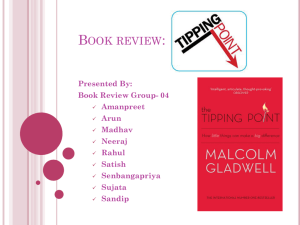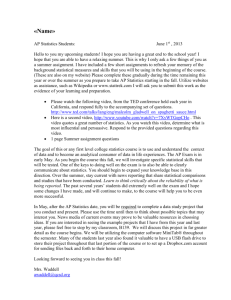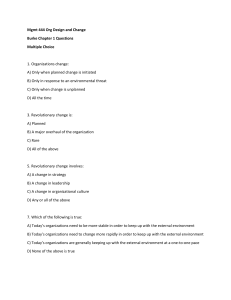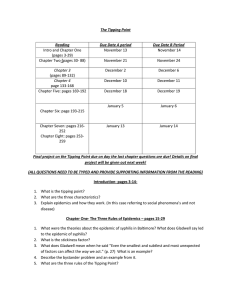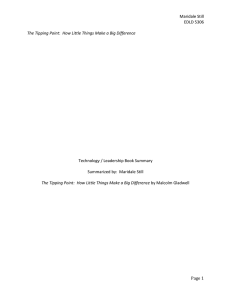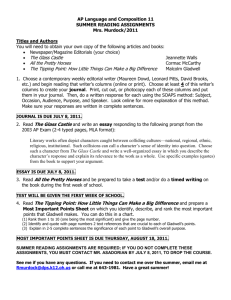writing center rhetorical essay 6-26-14
advertisement
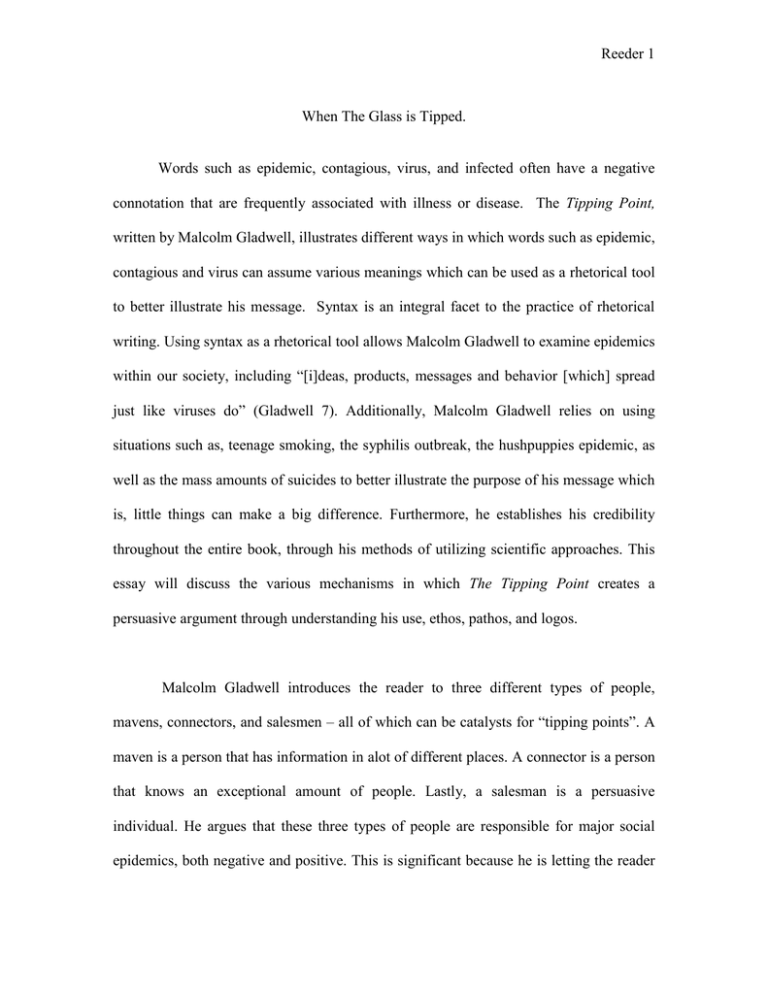
Reeder 1 When The Glass is Tipped. Words such as epidemic, contagious, virus, and infected often have a negative connotation that are frequently associated with illness or disease. The Tipping Point, written by Malcolm Gladwell, illustrates different ways in which words such as epidemic, contagious and virus can assume various meanings which can be used as a rhetorical tool to better illustrate his message. Syntax is an integral facet to the practice of rhetorical writing. Using syntax as a rhetorical tool allows Malcolm Gladwell to examine epidemics within our society, including “[i]deas, products, messages and behavior [which] spread just like viruses do” (Gladwell 7). Additionally, Malcolm Gladwell relies on using situations such as, teenage smoking, the syphilis outbreak, the hushpuppies epidemic, as well as the mass amounts of suicides to better illustrate the purpose of his message which is, little things can make a big difference. Furthermore, he establishes his credibility throughout the entire book, through his methods of utilizing scientific approaches. This essay will discuss the various mechanisms in which The Tipping Point creates a persuasive argument through understanding his use, ethos, pathos, and logos. Malcolm Gladwell introduces the reader to three different types of people, mavens, connectors, and salesmen – all of which can be catalysts for “tipping points”. A maven is a person that has information in alot of different places. A connector is a person that knows an exceptional amount of people. Lastly, a salesman is a persuasive individual. He argues that these three types of people are responsible for major social epidemics, both negative and positive. This is significant because he is letting the reader Reeder 2 know that these types of people are responsible for acting as persuasive mechanisms. He visits different subcultures, where dissimilar phenomena occur, from the sudden popularity of hushpuppies, to the outbreak of syphilis. These are examples of what Malcolm defines as, “The tipping point [which] is a moment of critical mass, the threshold, the boiling point” (Gladwell 12). It is the point where something that seems insignificant can cause a massive effect. With that being said, Malcolm Gladwell’s message is simple, little things can make a big difference. His credibility is constructed mainly through the use of statics, and research. He uses many diverse sources from universities, epidemiologists, and physiologists to further reinforce his rhetorical strategy. When these elements are mixed together with interviews and other forms of research, it makes for a exceptionally strong argument. Additionally, there are sources he uses come from universities, physiologists, and surveys done by different companies; such as but not limited to: Center for Disease Control, University of Massachusetts, University of Kansas, and psychologist Robert Provine. Another way he establishes credibility is through presenting to the reader that he was a reporter for the Washington Post, a science writer, and is now working for the New Yorker. With that being said, the reader may now have understanding that Malcolm Gladwell is knowledgeable in what he is writing about. Moreover, another element that reinforces his credibility is that fact that for every single story and every piece of data, he provides a valid source. These sources not only prove to the reader that the there is validity to his main argument, but also Malcolm Gladwell presents the data it in an accurate way. On a different note, the appearance of the book is also important in establishing his credibility. For example, on the cover at the top it says,”#1 National Bestseller,” at the bottom it has Reeder 3 a quote from fortune magazine. When you flip over the book there are statements made by the Seattle Times, San Francisco Chronicles, and Time Out magazine. This simple tactic of including certain elements such as those listed above, facilitates his rhetorical strategy. An element that is essential to his rhetorical strategy is his methodology to figuring out how an epidemic was caused. The way he incorporates the case studies and the research explains to the reader how each situation is directly correlated to his claim, that little things can make a big difference. For example, he conducted an experiment in which he asked several dozens of people to go through a list of two hundred and fifty names, and pick out every person’s name that they knew. The average outcome was 21 people that were known. He conducted this experiment to examine who a connector might be. He also conducted an experiment in which he studied “conversational rhythm.” He videotaped an interview, where he was on one side of a desk and another man was on the other side. He slows down the tape for a few seconds to show a certain type of rhythm that a conversation has. Since he uses actual data and controlled experiments, he not only proves his message in a compelling and interesting way, he does it in a scientific way. This appeals to the readers’ appreciation of logic or a sense of logos; having the scientific data there to support his claim makes the reader really convinced that the tipping point is an actual phenomenon in our society. This very element creates a strong and convincing argument. Logos is an essential device used by Malcolm Gladwell to create a solid argument throughout his book. When the reader is going through the book, he or she reads about seemingly unconnected situations; however, when they reach the end it becomes apparent Reeder 4 that the situations are connected through two critical ideas about how social connections are made: personification and communication. One idea is that connections are made through communication, often discussed as “word of mouth.” Keep in mind that this book was written before YouTube, and Twitter, so the “word of mouth” epidemic seems like a valid connection between the stories. The other idea about how connections are made is through personification or characterization of three main types of people, whom were discussed earlier, the mavens, connectors, and salesmen. These are people who are very capable of starting the word of mouth epidemic, or any type of contagious behavior in society. Throughout this book the text is consistently using logical appeals. With that being said, using that main element allows the reader to get a sense of organization, which makes the reader contently interested throughout the entire book. Additionally, he ties each element together so well it gives the reader a feeling that the text has propose and meaning. The fact that everything is tied together in the end, gives the reader a sense of closure. Since the book came together so well in the end, the arguments are made even more concrete. This is vital because he reinforces each situation then he ties them together, which leaves few ways to tear down his argument. Along with using a logical approach, he uses a wide array of metaphors to convey his message. For example, throughout the text he uses words like contagious, virus, epidemic, raging, symptom, and tipping point. Most of these words are usually connected with sickness, which of course is not what he is referring to. He is referring to the tendency of humans to be easily infected with the ideas and behavior of other people. The unstated assumption would be that each event that takes place in our society spread like Reeder 5 diseases and sickness do. If one thinks about the level of difficulty it takes to spread a disease, it not difficult to start an epidemic. What he is saying is ideas, messages, and behavior spread easily through society, and one insignificant factor can be the tipping point for an epidemic. Just like the other words, “tipping point” are used figuratively to give the reader a visual of something literally tipping over. When you imagine a glass tipping over, you see all the contents inside spilling out and spreading over a surface. The liquid is like an idea or message, the surface is like society, and the external force that caused it to tip is like a maven, connector, or salesman. Through his use of these words and the idea that three different types of people can cause a tipping point, he effectively connects each situation he writes about. Furthermore, using words that usually have negative connotations is an effective way of appealing to a readers emotions. Malcolm Gladwell’s book appeals to a wide range of audiences. Although his message is obvious, his target demographic is not; ambiguity aids in his rhetorical strategies. It could range anywhere from young adults, to elderly citizens, or just simply to people who are interested in behavioral science. Mostly, he targets people who are interested in the behavior of society as a whole. This is important because knowing your audience is an integral facet to not only rhetorical pedagogy, but also a rhetorical analysis. Overall we know that whatever his audience may be we know that he is trying to convince his audience that little things can make a big difference. One can look through his uses of relevant and shocking examples, where he tantalizes readers by appealing to their concern for major social problems, and appealing to their sympathy, outrage, or any range of emotions. For example, he writes about this young boy that committed suicide by hanging himself. Within the passage he uses words Reeder 6 and phrases like deeply pathological, ritual, self destruction, and rebellion. Deeply pathological could be use to instill fear into the reader. Ritual is a word that might often be associated with factors in a society that are particularly taboo. Self destruction and rebellion are also words that can make the reader feel emotions which are not exactly positive. The use of these negative words throughout the book is evident, however, it is all necessary to get his message across. There is an understanding that an emotional response can be a strong response; which could allow him to effectively get his message across. Another example would be when two executives appeared on the cover of a major magazine, they were wearing hush puppies. This was the tipping point for the trend. The reason this example was so effective is because hush puppies are something a lot of people are familiar with. When people find something they are familiar with, it gives them a positive feeling, and that makes them more interested which makes them want to read on. This method is used throughout the book, even with the negative examples, such as teenage smoking and the cluster of suicides. Another claim he makes is epidemics happen dramatically not gradually. Each situation that he presents throughout the book is something that happened very quickly Malcolm Gladwell’s main argument was that little things can make a big difference, and sometimes these changes happen quickly and dramatically. The fact that he uses the term “dramatically” to describe rapid movement of the epidemic, can make the reader feel a sense of urgency . In summation, Malcolm Gladwell reinforces his argument effectively through that various mechanisms of his rhetorical strategies. He effectively argues that little things can Reeder 7 indeed make a big difference. The Tipping Point illustrates this effectively, through the uses of syntax, scientific evidence, his credibility, and through logical appeals. This can make the reader think twice about the possible implication he or she could have on a society. Malcolm Gladwell shows the reader that, “with the slightest push, in just the right place, it can be tipped.”(Gladwell, 259) Overall, Malcolm Gladwell demonstrates though his use of pathos, ethos, and logos, that even the simplest of arguments can be argued effectively through using pathos ethos and logos. Reeder 8 Works Cited Gladwell, Malcolm. The Tipping Point: How Little Things Can Make a Big Difference. Boston: Little, Brown, 2000. Print.
